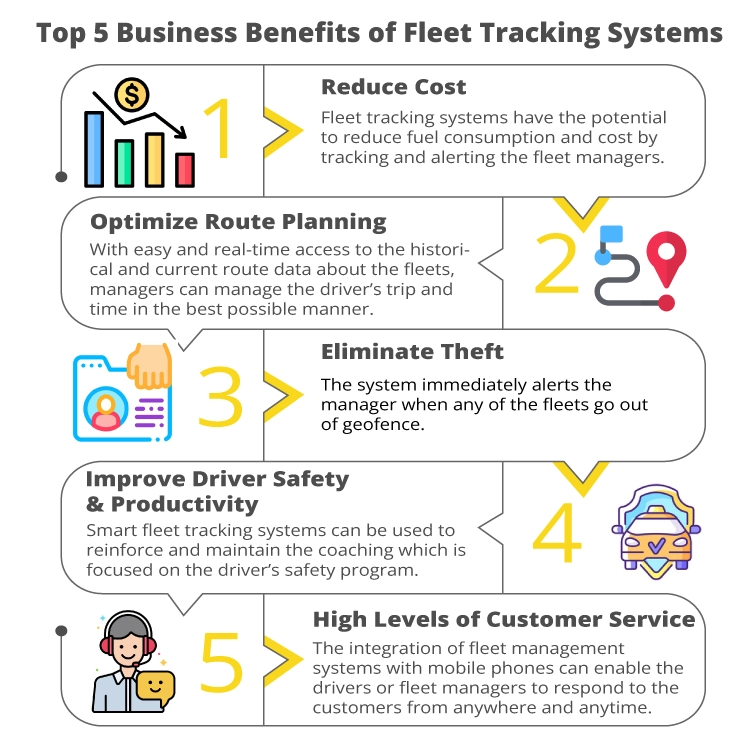Every industry is focusing on digital transformation as businesses all around the globe are aware of the fact that technology adoption can make them competitive and can maximize their productivity and revenues. Fleet management or the trucking industry is no different in this regard. Slowly and gradually, this industry is also progressing in digital transformation by integrating smart transportation technologies in order to maintain their day to day operations more efficiently.
The technology that is gaining dramatic momentum in the fleet management industry is Telematics or Fleet tracking system. This smart system uses GPS technology to monitor the movements of trucks, vehicles and other important assets on a computerized map. GPS tracking for fleets offers real-time tracking of each vehicle and saves the fleet managers from relying on redundant and cumbersome paperwork. To a greater extent fleet tracking systems are found to be extremely useful and have a wide range of benefits for the industry. The article discusses the top 5 business benefits that fleet managers can achieve by using the fleet tracking system.

1. Reduce Cost
Unmonitored trucking fleets lead to the waste of valuable resources and inefficient fuel consumption which in turn increases the operating cost. Fleet tracking systems have the potential to reduce fuel consumption and cost by tracking and alerting the fleet managers in terms of inefficient routing, excess idling of the trucks and driver behaviour. For instance, by tracking the real-time location of each fleet, truck drivers or managers can see the optimal routes which can be used to reach the desired destination without burning fuel. In other words, shorter and faster routes transform to lower fuel consumption. Secondly, by looking at the idling and location data, fleet managers can identify the problem areas and supervise the drivers to turn off their engines if the vehicle is not in use. This reduces the fuel cost and operating cost along with improving overall vehicle utilization.
2. Optimize Route Planning
With easy and real-time access to the historical and current route data about the fleets, managers can manage the driver’s trip and time in the best possible manner. Fleet management systems usually combine GPS and real-time mapping data, and this combination provides the most recent data regarding the road conditions and traffic along with the real-time location of the fleet. The system helps the drivers in a quick rerouting as per the traffic or weather conditions. GPS tracking systems for fleets can also provide trip history data for each vehicle. The analysis of this data can reveal patterns regarding traffic congestion at certain times of the day on the specific road so that drivers can avoid such routes while planning their trips.
3. Eliminate Theft
Fleet companies face nearly 30 billion USD loss annually in vehicle and cargo theft. Fleet tracking systems allow you to track your important assets in real-time. Knowing exactly where your asset is all the time can prevent it from getting stolen. By using fleet tracking systems, fleet managers can create custom geofence on the map, which includes the pickup and delivery point of the truck, and the surrounding area. This virtual boundary prevents the trucks from going out of the physical location where they are not required to. The system immediately alerts the manager when any of the fleets go out of geofence. This also ensures the driver’s safety by making them stick to their routes. In addition to this, route replay can facilitate fleet managers to identify the unauthorized side of the trips and lengthy stops along with locating the cargo that might be stolen. This can significantly reduce damage and financial loss.
4. Improve Driver Safety and Productivity
The most important asset of the fleet management companies is their drivers, and fleet management systems can help in ensuring their safety. The fleet tracking system also has a feature to playback the individual routes, which highlights the animated trail if any of the drivers is overspeeding, which might be harmful to their life. By using this data, fleet managers can arrange a training sessions for the drivers to improve their driving skills. Furthermore, when the drivers practice courteous and safe driving, then it leaves a positive impression on others as well, who might be sharing and road with the truck driver. IoT fleet monitoring systems hold the potential to reduce safety-related incidents by 20%. Smart fleet tracking systems can be used to reinforce and maintain the coaching which is focused on the driver’s safety program. This can improve the overall productivity and safety of the drivers on the road.
5. High Levels of Customer Service
One of the most potential benefits of a fleet tracking system is high levels of customer service. The majority of the fleet companies are looking for ways through which the immediate fleet status can be found in order to deliver a five-star customer experience and increase customer satisfaction. For instance, the monitoring of the arrival estimates of each truck can reduce the number of incoming calls from customers, asking for the delivery status. Fleet managers can utilize fleet tracking systems to quickly identify the vehicle that might be closest to the service destination so that they can easily respond to changing or new customer requests. The integration of fleet management systems with mobile phones can enable the drivers or fleet managers to respond to the customers from anywhere and anytime.
In Conclusion…
With fleet tracking, fleet operations can easily be streamlined and automated. This smart system can also improve the communication among the fleet managers, customers and drivers. The real-time tracking of the vehicles enables fleet managers to make data-driven decisions and improve fleet productivity. With fleet tracking systems, the managers and the driver have lesser things to worry about and get the work done in less time while achieving the delivery targets efficiently.




